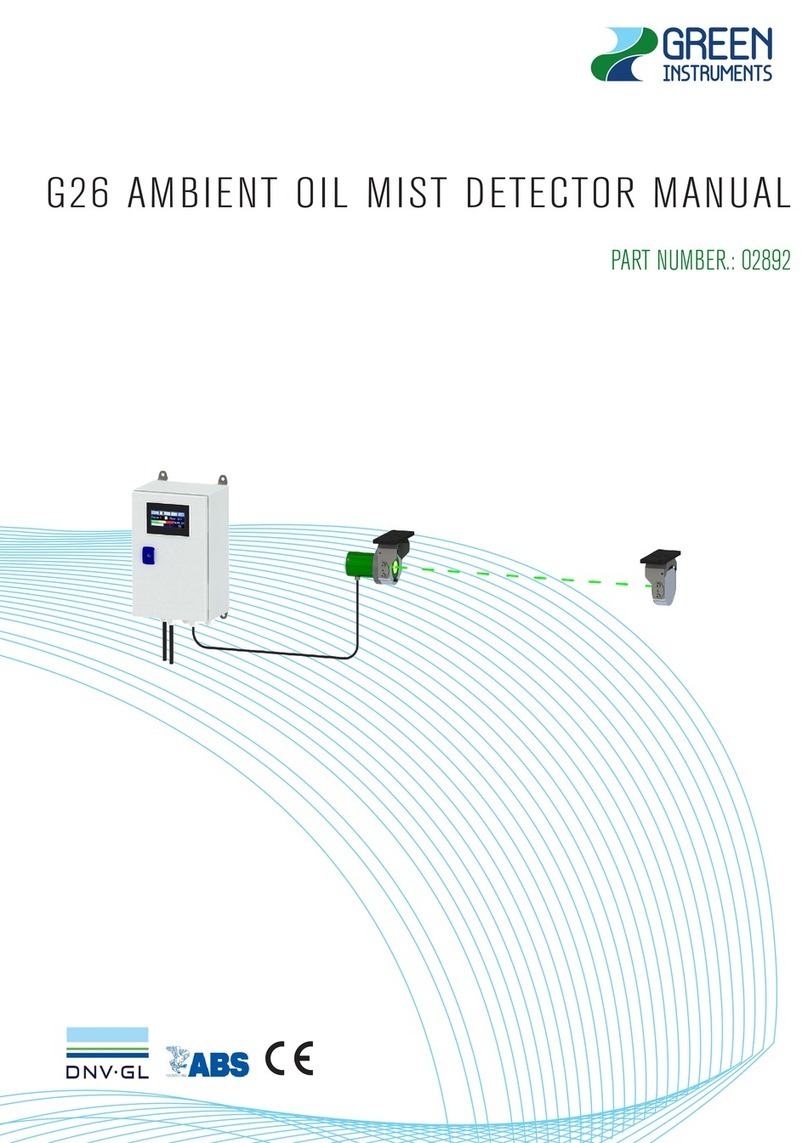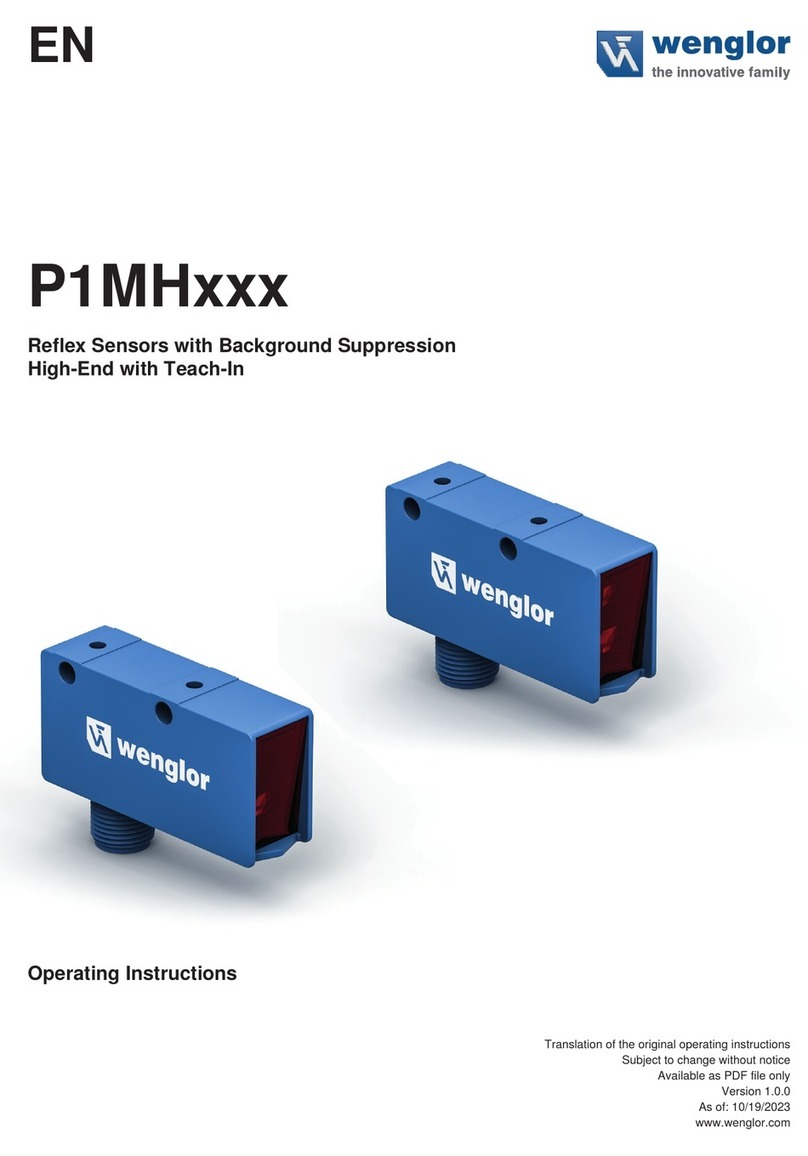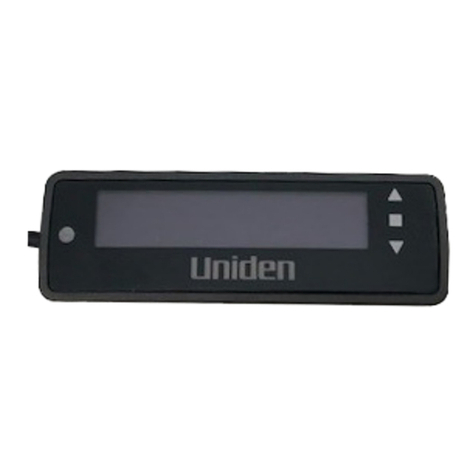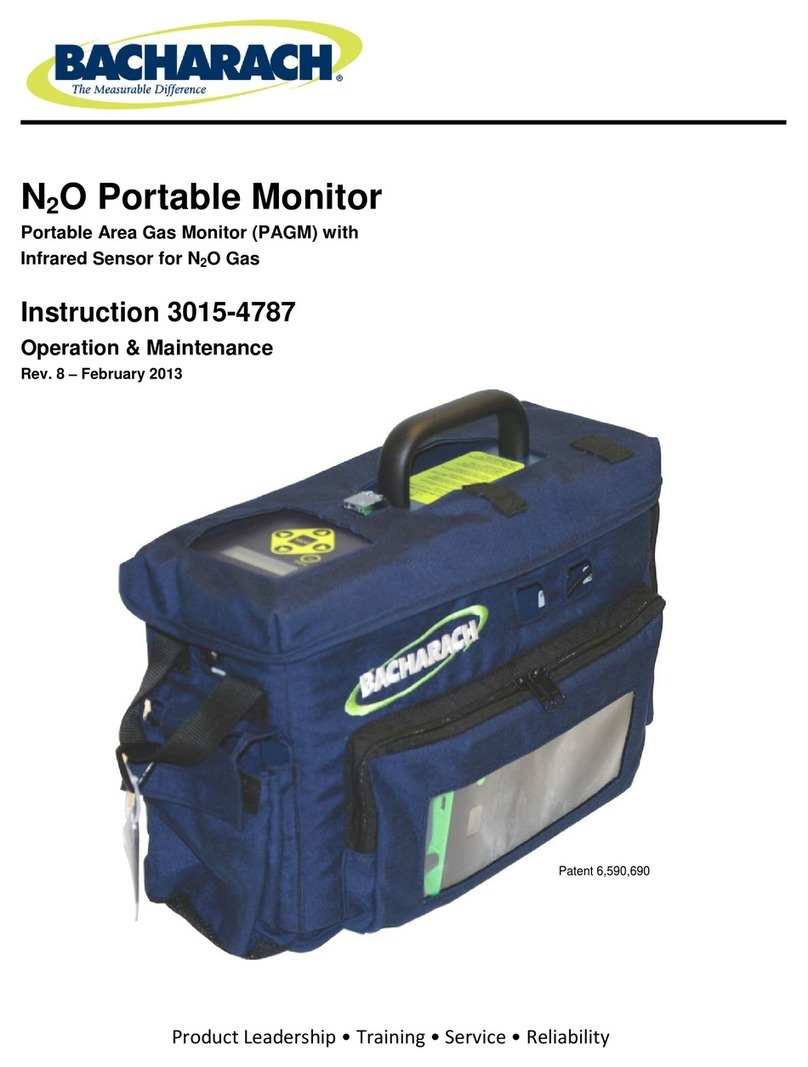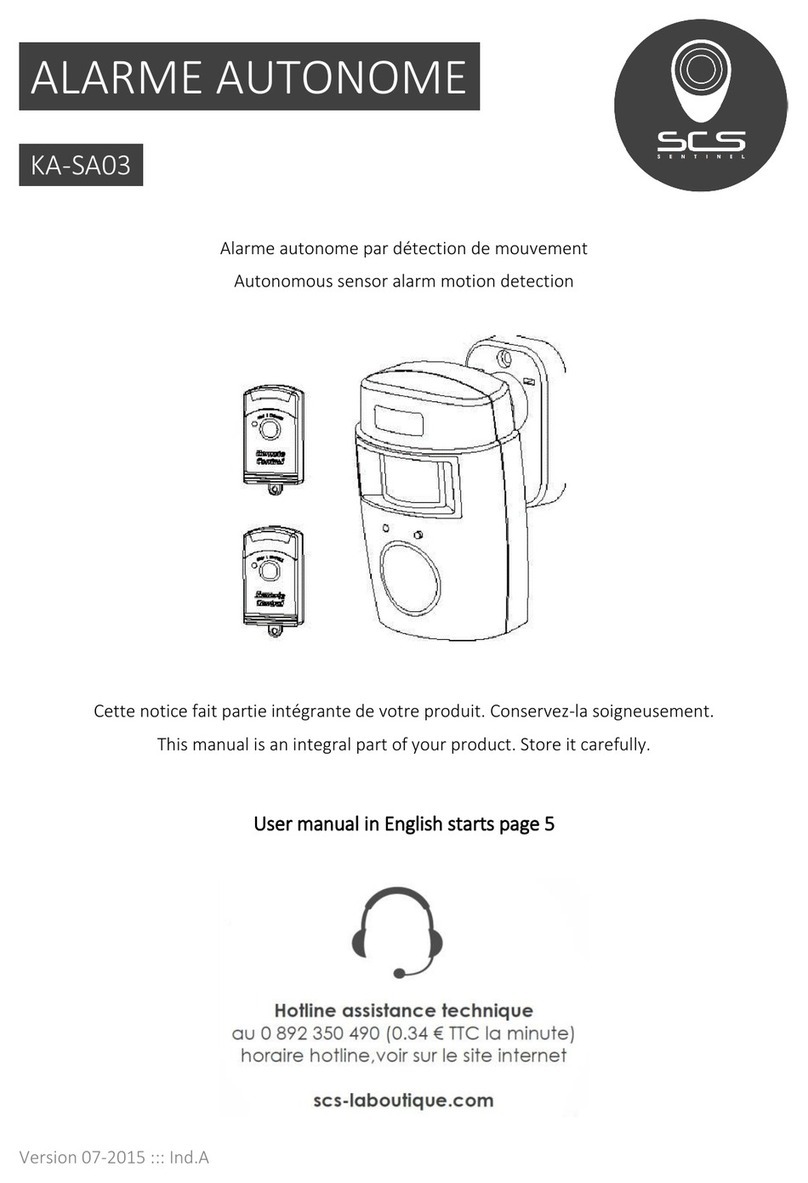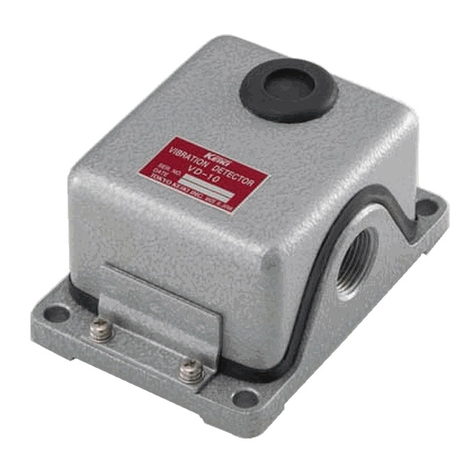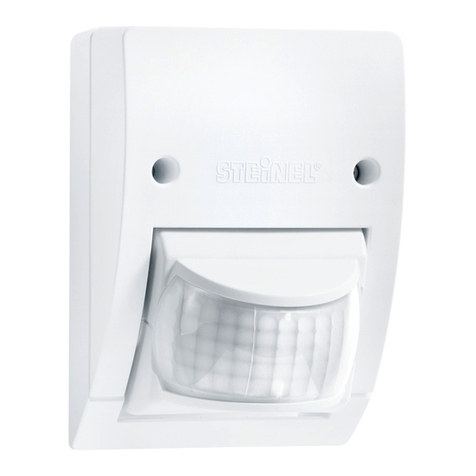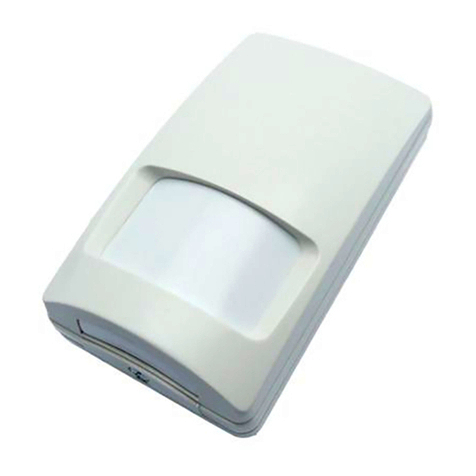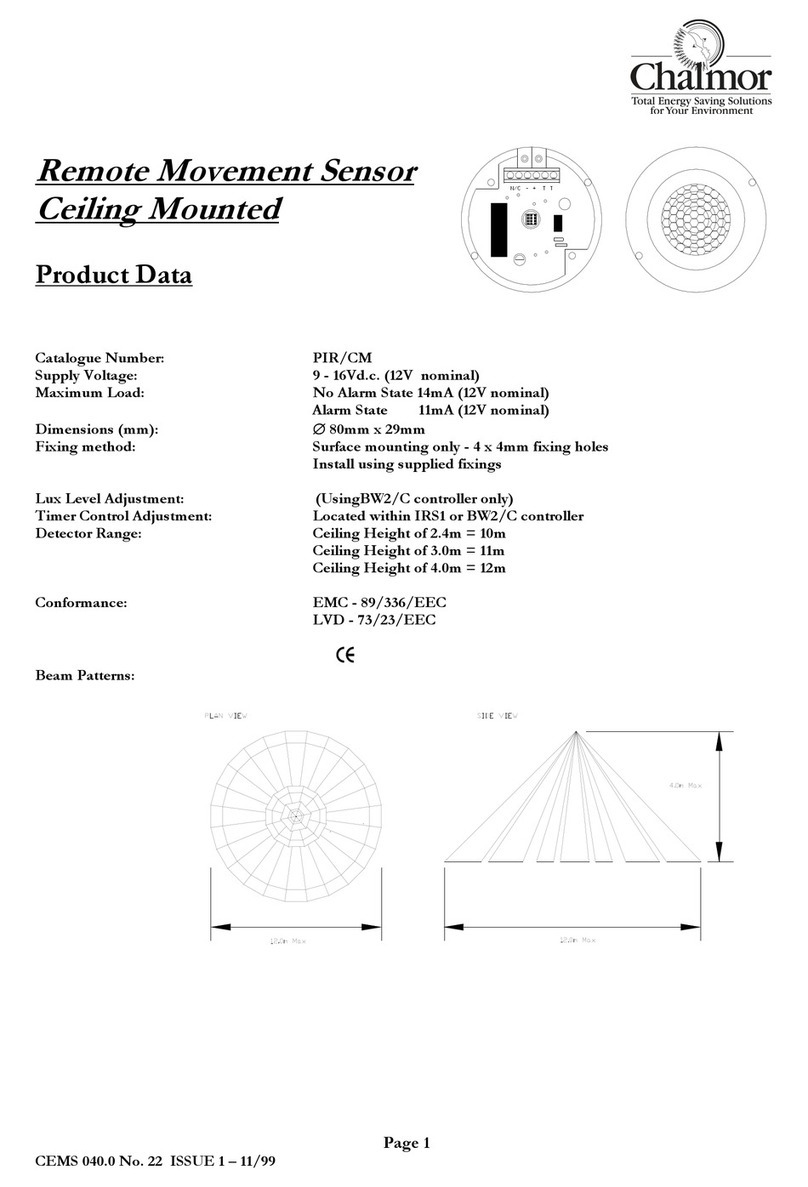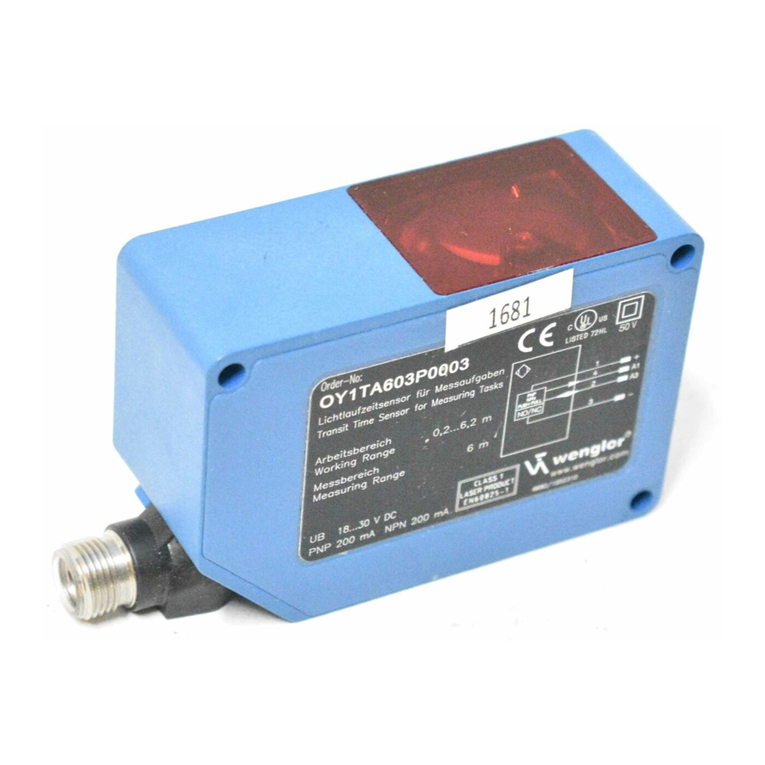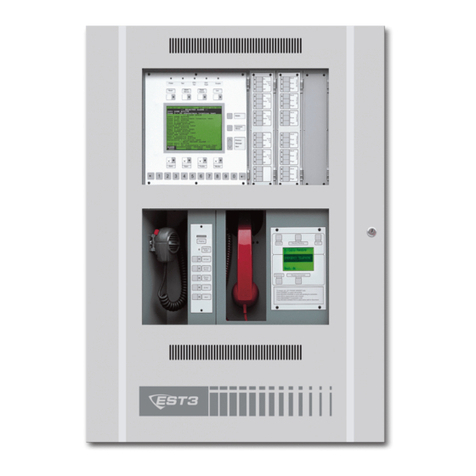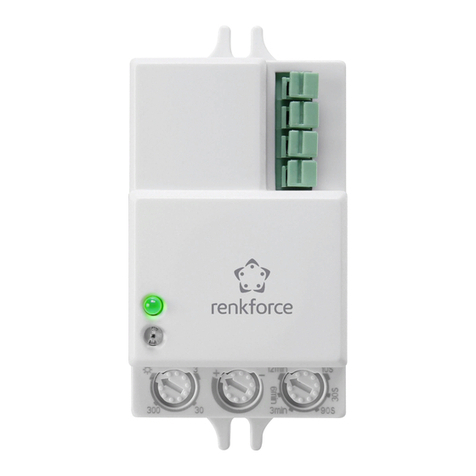GREEN INSTRUMENTS G26 User manual

G26
Ambient Oil Mist Detector
Instruction Manual
Document ID number.: 02892

Content
2
Content
1INTRODUCTION 4
1.1 ABOUT THIS MANUAL 4
1.2 INQUIRIES AND FEEDBACK 5
1.3 ABOUT THE SYSTEM 5
1.3.1 System components 6
1.3.2 Additional components 6
1.4 CHOOSINGTHERIGHTALARM LEVELS –OPACITY OFOIL MIST 6
2SPECIFICATIONS 8
3INSTALLATION 10
3.1 GENERAL 10
3.1.1 Control at Delivery 11
3.1.2 Safety Aspects 11
3.1.3 Symbol identification 12
3.2 STANDARD INSTALLATION 12
3.2.1 Welding and Alignment Brackets 12
3.2.2 Transceiver and Reflector 14
3.2.3 Junction box 15
3.2.4 Control and Monitoring Unit 15
3.3 ELECTRICAL CONNECTIONS 15
3.3.1 Connections 15
3.3.2 Cable types 15
4MENU STRUCTURE &CONFIGURATION 16
4.1 TRANSCEIVER 16
4.1.1 Transceiver button function 16
4.1.2 Set laser aligning function 18
4.1.3 Set unit address 19
4.1.4 Save new settings 20
4.1.5 Enabling Service Mode 21
4.2 CONTROLAND MONITORING UNIT 24
4.2.1 Home menu 24
4.2.2 Sensor menu 25
4.2.3 Alarm list menu 26
4.2.4 Trend menu 30
4.2.5 Sensor Setup 30
4.2.6 System Setup 32
5CALIBRATION 34
5.1 ZERO CALIBRATION 34
5.2 AUTO SPAN CALIBRATION 34
5.3 MANUAL SPAN CALIBRATION 35
6COMMISSIONING 37
6.1 START OF THE SYSTEM 37
6.2 CALIBRATION 37

G26 Ambient Oil Mist Detector
Ver.2.0 –Revision March 2022 3
6.3 SETTING OF ALARM LEVELS 37
6.4 SETTING OF SIGNAL OUTPUTS 37
7MAINTENANCE 38
8TROUBLESHOOTING 39
9SPARE PARTS 40
10MAINTENANCE INSTRUCTION 42
TABLE OF FIGURES
FIGURE 1-1: OPACITY VERSUS PATH LENGTH FOR DIFFERENT CONCENTRATION 7
FIGURE 3-1: ILLUSTRATION OF A G26AMBIENT OIL MIST DETECTOR WITH TRANSCEIVER/REFLECTOR UNIT 13
FIGURE 3-2: MOUNTING POSITION OF THE TRANSCEIVER AND THE REFLECTOR 13
FIGURE 3-3: INSTALLATION OF TRANSCEIVER 14
FIGURE 3-4: INSTALLATION OF REFLECTOR 14
FIGURE 4-1: TRANSCEIVER INTERFACE 16
FIGURE 4-2: ILLUSTRATION OF THE STRONGEST SIGNAL,NO OBSTRUCTIONS TO THE LIGHT BEAM 17
FIGURE 4-3: ILLUSTRATION OF THE WEAKEST SIGNAL,OBSTRUCTIONS TO THE LIGHT BEAM 17
FIGURE 4-4: ILLUSTRATION OF POOR ALIGNMENT 18
FIGURE 4-5: ILLUSTRATION OF GOOD ALIGNMENT 18
FIGURE 4-6: TRANSCEIVER ADDRESS SETTINGS 19
FIGURE 4-7: SYMPTOM OF ADDRESS CONFLICT 20
FIGURE 4-8:ACCIDENTADDRESS CHANGE (2 SENSORS HAVE THE SAME ADDRESS) 20
FIGURE 4-9: THE ILLUSTRATION OF INTERFACE SHOW -ENTER TO SERVICE MODE 21
FIGURE 4-10: SERVICE MODE (FLASHING WARNING LED) 22
FIGURE 4-11: SERVICE MODE (1 SIGNAL STRENGTH LED REPRESENTS 10MINUTES) 22
FIGURE 4-12:THE SERVICE MODE TIMER INDICATION MAX 60 MINUTES 22
FIGURE 4-13: HOME MENU WITH 1CONFIGURED SENSOR 24
FIGURE 4-14: HOME MENU WITH 2CONFIGURED SENSORS 24
FIGURE 4-15: SENSOR MENU 26
FIGURE 4-16:ALARM LIST MENU 26
FIGURE 4-17: SELECT AN ALARM IN THE ALARM LIST MENU 27
FIGURE 4-18:ALARM INFO SCREEN -E.G.NOT ALIGNED ALARM 27
FIGURE 4-19: TREND MENU 30
FIGURE 4-20: PASSWORD POPUP WINDOW 30
FIGURE 4-21: SENSOR SETUP 31
FIGURE 4-22: SYSTEM SETUP 32
FIGURE 5-1:AUTO SPAN CALIBRATION READY TO STARTAFTER THE ZERO CALIBRATION IS COMPLETE 34
FIGURE 5-2: LASER BEAM HAS BEEN BLOCKED –AUTO SPAN CALIBRATION REGISTERING 35
FIGURE 5-3:AUTO SPAN CALIBRATION ACCEPTED –NOW UNBLOCK THE BEAM OF LIGHT 35
FIGURE 5-4: THE TRANSCEIVER IN NORMAL OPERATION MODE 36

Introduction
4
1Introduction
1.1 About this Manual
This manual contains data and instructions for the installation, operation, and mainte-
nance of the G26 Ambient Oil Mist Detector.
The instructions are given in general terms and do not take into consideration a specific
installation. As such, the instruction manual is designed for the Ambient Oil Mist Detec-
tor delivered by Green Instruments A/S.
Note that each Ambient Oil Mist Detecting System is configured at the factory according
to specifications. Therefore, please study this manual and the Technical Drawings for
each system in their entirety for the operation of the system.
The manual does not describe all possible situations, but only the most common and
known situations. It cannot replace the necessary education and training of the personnel.
Should situations not described in this manual occur that cannot be solved in accordance
with normal known practice and good workmanship, the operator should contact Green
Instruments A/S for instructions.
Attention
Before operation, read all instructions and warnings within this manual and
associated documentation. Improper use may cause personal injury and/or damage
of equipment and may void the warranty. Green Instruments A/S disclaims any
responsibility for damage and/or injury caused by improper installation, use or
maintenance of the equipment
Green Instruments A/S reserves the right to minor alterations and improvements owing to
developments without being obliged to enter the corresponding changes in this manual.
Green Instruments A/S reserves the copyright of the manual. Without prior written per-
mission of Green Instruments A/S, the manual may not be copied and given to unauthor-
ized people.

G26 Ambient Oil Mist Detector
Ver.2.0 –Revision March 2022 5
1.2 Inquiries and Feedback
All claims and inquiries for spare parts shall be addressed to Green Instruments A/S or
our distributors. In all correspondence, or when ordering spare parts, please carefully
state the equipment type and serial number, which can be found on the label on the
equipment.
Green Instruments A/S appreciates all feedback and suggestions for improvement. If any
questions appear or any discrepancies are found in this manual, kindly contact Green
Instruments:
Green Instruments A/S
Erhvervsparken 29
DK-9700 Brønderslev, Denmark
Phone: +45 9645 4500
Fax: +45 9645 4501
Web: www.greeninstruments.com
1.3 About the System
The G26 Ambient Oil Mist Detector is designed to detect small concentrations of oil mist
in open spaces and provide an early fire hazard warning.
The system is usually installed in engine rooms, pump rooms, machinery locations and
other rooms with hydraulic installations, especially above hydraulic power packs and hy-
draulic aggregate pumps.
The G26 Ambient Oil Mist Detector uses a green laser light beam based on the principle
of light transmission. A light beam with specific spectral characteristics is projected
across the space to be monitored for oil mist leakage. The amount of light reflected back
to the instrument from the reflector after passing through the space is compared with the
maximum possible return when oil mist or smoke and other matters are not present in the
area. Thus, the level of return signal is an indication of oil mist or other particulate mat-
ters in the space attenuates the projected light beam.
Please note that besides reacting to oil mist, the G26 Ambient Oil Mist Detector also will
react to other obstructions intercepting the light beam e.g. smoke and dust. Consequently,
the reading will change and possibly trigger an alarm. Depending on the application, this
might be perceived as a "false alarm". At the same time, such alarms give you an indica-
tion of other malfunctions.

Introduction
6
1.3.1 System components
As a standard configuration, the G26 Ambient Oil Mist Detector consists of the following
standard elements:
Control and Monitoring Unit (HMI)
The control and monitoring unit is arranged with a touchscreen, connection terminals and
cable glands. The control and monitoring unit can be configured to monitor up to 2 trans-
ceivers.
Transceiver/Reflector Unit
The transceiver assembly contains the laser source, optical components, electronics and
data processer capacity to control and shape the laser beam projected across to the reflec-
tor assembly. The reflector assembly reflects the light back to the Transceiver Assembly
where the light attenuation is measured.
The reflector assembly contains a precision reflector to direct the light beam back to the
transceiver assembly.
1.3.2 Additional components
•Welding and alignment brackets for the transceiver and the reflector assemblies.
•Junction Box (JB). For each transceiver, a junction box is arranged with connection
terminals and cable glands.
•For system configured for more than 2 transceivers, another monitoring system can
be offered. Please contact our sales department for further information.
1.4 Choosing the Right Alarm Levels –Opacity of Oil Mist
The alarm levels of the G26 Ambient Oil Mist Detector can be adjusted to specific re-
quirements. The variable output as well as the display of the monitoring unit states the
level of opacity in percent, i.e. how much of the light that does not reach the receiver.
The alarm point value is freely programmed from 2 % to 100 % to suit the actual applica-
tion. There will be a warning alarm at 50 % of the alarm level, e.g. if the alarm is set at
10 % opacity, the warning will be at 5 % opacity.
The opacity of oil mist will depend on the concentration of oil mist, the size of oil
droplets, and the path length of the actual oil-mist cloud which intersects the light beam.
Regarding the size of oil droplets, in general, smaller oil droplets have lower ignition
temperatures due to the larger surface to volume ratios. Larger oil droplets are less
dangerous due to higher ignition temperatures. This corresponds well with the fact that

G26 Ambient Oil Mist Detector
Ver.2.0 –Revision March 2022 7
smaller droplets have a higher opacity effect and are thus easier to detect than larger
droplets.
In order to understand the relationship between opacity, oil mist concentration and the
path length of the oil mist, two fictive examples are given in Figure 1-1. The figure
illustrates different oil mist opacity levels corresponding with different oil concentrations
and path lengths for a fictive oil type with oil droplets ranging from 10…20 µm.
The figure shows that:
•An oil mist cloud with a concentration of only 0.2 mg/l and a path length of
approximately 2 meters will generate an opacity of approximately 10 %.
•For the concentration of 2.5 mg/l, a mist cloud intersecting the line of sight by only
25 cm will generate an opacity of approximately 16%.
0%
10%
20%
30%
40%
50%
60%
70%
80%
90%
100%
25 50 75 100 125 150 175 200 225 250 275 300 325 350 375 400
Path length in cm
Opacity in %
0.2 mg/l 1.0 mg/l 2.0 mg/l
2.5 mg/l 50 mg/l
Figure 1-1: Opacity versus path length for different concentration

Specifications
8
2Specifications
Control and Monitoring Unit
Power supply Input
Option 1: 100–240 VAC –50/60 Hz –1.4 A
Option 2: 20 - 30 VDC –2 A
Ambient temperature
0 °C–55 °C
Communication options:
(All included as standard)
Analog output:
2 x 4…20 mA max. 500 Ω - (active & linearized)
Digital output: 4 x Alarm Relays
Bus - Modbus TCP/IP
Alarm levels
Alarm level is configurable
Warning level is automatic set at 50% of Alarm level
Alarm delay
Default 0 s (programmable 0–1800 s)
Display
Opacity level [%]
Accuracy
≤2 % of full scale
Dimensions/weight
H×W×D: 300 × 200 × 150 mm / 5.5 kg
Enclosure
IP 65 Steel box
Transceiver
Measurements
Opacity
Measuring principle
Transmission double pass
Measuring range
0–100% Opacity
Scanning distance
1.0 to 15.0 m
Power supply
24 VDC +/- 10%
Ambient temperature
0 °C–55 °C (Class A)
Vibration Class
B
EMC Class
A
Enclosure Class
B/IP 66
Dimensions & weight
LxHxW: 150x116x140 mm/1.7 kg
(incl.mounting brackets)
Reflector
Ambient temperature
0 °C–55 °C (Class A)
Humidity
Above dew point
Vibration Class
B
Enclosure Class
B/IP 66
Dimensions & weight
LxHxW: 52x116x140 mm/1.3 kg
(incl. mounting brackets)

G26 Ambient Oil Mist Detector
Ver.2.0 –Revision March 2022 9
Optional Equipment (refer to spare part section 9)
Support and alignment
brackets
Mild steel for welding. Used in case of mounting on structures
with thickness less than 6 mm
Audit targets
100, 22 & 8 % Opacity (+/÷ 2% of full range)
Useable for field validation
Visualization, recorder and data logging (Upon request)
Remote digital display for panel mounting (Upon request)
Approvals and Certificates
Download all product certificates at https://greeninstruments.com

Installation
10
3Installation
Read this chapter in its entirety before installing the system.
3.1 General
To avoid possible damage to the equipment or errors in the monitoring readings and
alarm function, it is important to observe the following points carefully:
•The transceiver and reflector modules must be placed in areas with low vibration and
with ambient temperatures below 55 °C. The location must be suitable for service and
cleaning.
•The alignment brackets must be secured to solid structures –typically bulkheads
providing a vibration stable location for the transceiver and reflector assemblies. The
transceiver and reflector must be properly aligned and mounted firmly and stable, di-
rectly opposite each other.
•If mounted on to structures thinner than 6 mm, it is recommended to fit a double plate
to the structure in order to support the Welding Brackets.
•The transceiver and reflector must be protected against mechanical damage. After the
fine alignment of the transceiver and reflector, all bolts and screws must be firmly se-
cured and tightened. Please see Figure 3-1, Figure 3-2, Figure 3-3 & Figure 3-4 for
installation of transceiver & reflector.
Attention
Installation and operation of the G26 Ambient Oil Mist Detector and associated
equipment must be carried out by skilled personnel. Green Instruments A/S does
not take any responsibility of the operation of the system and associated equip-
ment whatsoever.
The equipment must only be applied as specified by Green Instruments. If the
equipment is used in a manner not specified by Green Instruments, the protection
provided by the equipment may be impaired.
The successful and safe operation of this equipment is dependent upon proper
handling, installation, operation, and maintenance.

G26 Ambient Oil Mist Detector
Ver.2.0 –Revision March 2022 11
3.1.1 Control at Delivery
Upon receipt of the G26 Ambient Oil Mist Detector, please inspect and confirm that the
received items are in accordance with the packing list and not damaged. Any discrepancy
should be reported to the supplier immediately. If any of the received parts are damaged,
the shipping company should be informed, and new parts made available before complet-
ing the installation.
3.1.2 Safety Aspects
WARNING!
Follow the installation and operating instructions. Please read the instructions carefully in
its entirety before working on the system.
WARNING!
Hazardous Voltage: Disconnect power before servicing the system. Ignoring this warning
can result in severe personal injury or material damage. Observe the instructions careful-
ly to ensure the correct connection of all power and signal leads.
Ensure that the correct power supply is connected to the control and monitoring unit (see
the rating marked on the label of the equipment).
Circuit breaker!
The installation must include a means of switching off electrical power by a clearly
marked switch or circuit breaker external to the control and monitoring unit. The external
switch or circuit breaker must be placed in close proximity to the monitoring unit and
within reach of the operator.
Overload protection!
To comply with safety requirements IEC 61010-1 (2003), the installation must include a
means of overcurrent protection to protect against excessive energy being drawn from the
power supply system in case of a fault in the equipment.
Protective earth!
The monitoring unit must be connected to protective earth.
Installation and fault finding!
Electrical installation and fault finding on the system should only be undertaken by a
suitable trained and qualified engineer.
Warning Laser Hazard
Visible laser radiation! Avoid eye exposure to direct or scattered radiation.

Installation
12
3.1.3 Symbol identification
Caution, risk of danger
Caution, risk of electrical shock
Warning Laser Hazard. Visible laser radiation! Avoid eye exposure to direct or
scattered radiation.
Protective earth
The CE mark proves the compliance of the instrument with the requirements of
the relevant EU directives
3.2 Standard Installation
A G26 Ambient Oil Mist Detecting System can consist of up to 2 sensors (i.e. transceiv-
er/reflector units). Other systems configuration supporting up to 16 sensors available up-
on request. The installation of each transceiver/reflector unit is similar to each other. Fig-
ure 3-1 illustrates the installation of a system with a transceiver/reflector unit.
The transceiver and reflector are to be mounted and aligned opposite each other in a way
that the light beam from the transceiver hits the reflector at the center. After the fine ad-
justment of the transceiver and reflector alignment, all bolts and screws must be firmly
secured.
3.2.1 Welding and Alignment Brackets
The transceiver and reflector are installed into solid brackets, i.e. the alignment brackets
mounted on the welding brackets, see Figure 3-2.
The solid mild steel welding brackets allow easy mounting to existing structures by
welding or alternatively bolting. Please note that thin structures will require additional
support in order to secure stable alignment of the Transceiver and Reflector Assemblies.
In order to avoid false alarms caused by people walking in the monitoring area, it is rec-
ommended to mount the transceiver and reflector at a position higher than the normal
height of people (i.e. > 2200 mm from the floor) if possible.

G26 Ambient Oil Mist Detector
Ver.2.0 –Revision March 2022 13
Figure 3-1: Illustration of a G26 Ambient Oil Mist Detector with transceiver/reflector unit
Figure 3-2: Mounting position of the transceiver and the reflector

Installation
14
3.2.2 Transceiver and Reflector
The transceiver and reflector are mounted into the alignment brackets as illustrated in
Figure 3-3 and Figure 3-4.
Special attention must be given to the alignment, ensuring the transceiver and reflector is
mounted precisely centered and directly opposite each other.
Figure 3-3: Installation of transceiver
Figure 3-4: Installation of reflector

G26 Ambient Oil Mist Detector
Ver.2.0 –Revision March 2022 15
3.2.3 Junction box
The junction box is an optional item used in cases where the cable between the Control
and Monitor unit and the Transceiver exceeds 15 meters and/or in cases where multiple
transceivers are daisy chained together. If the scope of supply includes a junction box, the
junction box is pre-mounted with a connection cable for easy connection to the transceiv-
er.
The connection terminals are located in the junction box. Four (4) cable glands (M20) are
arranged for incoming and outgoing power and data cables. The M20 cable glands are
suitable for cable diameters between 7 mm to 13 mm.
3.2.4 Control and Monitoring Unit
The control and monitoring unit can interface with up to 2 transceiver/reflector units.
Other systems configuration supporting up to 16 sensors available upon request. It is rec-
ommended to install the control and monitoring unit in an easily accessible location.
The control and monitoring unit is arranged with touch screen and connection terminals
inside the unit. Five (5) cable glands (M20) are arranged for incoming and outgoing
power and data cables. The M20 cable glands are suitable for cable diameters between 7
mm to 13 mm.
3.3 Electrical Connections
3.3.1 Connections
Before connecting the power supply, please make sure that the power supply rating for
the control and monitoring unit corresponds with the power supply available.
Please see the electrical drawings relevant for installation attached to each system. The
system can be prepared for functions not relevant for all installations. These functions
will be marked as spare or as reserved for a specific purpose.
3.3.2 Cable types
Refer to electrical documentation.

Menu structure & configuration
16
4Menu structure & configuration
4.1 Transceiver
4.1.1 Transceiver button function
Figure 4-1: Transceiver Interface
The transceiver user interface consists of a green power LED, a yellow warning LED and
a red alarm LED, a zero and a span button, and 5 signal strength LEDs.
•Power: Green illuminating LED means power ON
•Warning: Yellow illuminating LED means Warning ON
•Alarm: Red illuminating LED means Alarm ON
•Signal Strength LEDs: Under normal operation, the signal strength LEDs indicate
how strong the light beam is reflected to the transceiver. When the first signal
strength LED on the right illuminates, it indicates the transceiver is receiving the
strongest signal back, i.e., the section between the transceiver and the reflector is
transparent with no obstructions to the light beam and the transceiver lens and the re-
flector are clean. Please see Figure 4-2.

G26 Ambient Oil Mist Detector
Ver.2.0 –Revision March 2022 17
Figure 4-2: Illustration of the strongest signal, no obstructions to the light beam
•When the illumination changes to one of the LEDs to the left, it indicates that the re-
flecting beam becomes weaker, i.e., the beam is scattered or blocked, or the trans-
ceiver lens and/or reflector become contaminated. When the illumination changes to
the last LED to the left, it means the opacity level is just above the warning level.
Thus, the signal strength illumination can give a quick indication on the opacity level
and/or the contamination level of the transceiver lens and/or the reflector. Please see
Figure 4-3.
Figure 4-3: Illustration of the weakest signal, obstructions to the light beam
•Beside the indication of signal strength, the blue LEDs are also used for indication in
connection with initial alignment and address settings.
•Zero and Span: The Zero and Span buttons are used for calibration and initial settings
of light beam strength and transceiver address. Note that during initial setting of the
light beam strength, the laser light will be steady providing good access for fine
alignment of the beam against the reflector.

Menu structure & configuration
18
4.1.2 Set laser aligning function
WARNING
Once you start laser aligning function (section 4.1.2), you need to continue with
setting unit address (section 4.1.3) until the new settings are saved (section 4.1.4).
Visible laser radiation! When the transceiver operates in pulsed mode, the laser is
classified as Class 1, which is safe under all conditions of normal use. When it
operates in the continuous mode (i.e. there is a steady light beam in the aligning
mode), the laser is classified as Class 3R. Thus, please avoid eye exposure to direct
or scattered radiation when the transceiver operates in the continuous mode.
During laser aligning step, all possible obstructions to the light beam (such as oil
mist, smoke and dust) must be absent in the section between the transceiver and
the reflector.
To enter laser alignment mode please press and hold SPAN and ZERO buttons and wait
approximately 5 seconds until all signal strength LEDs turn ON. Then release SPAN and
ZERO.
The signal strength is indicated by means of one of the blue LEDs. Note that alarm and
warning function will be deactivated, while the steady/continuous beam of light is ON.
The laser beam can now be adjusted to hit the centre of the reflector by adjusting the
support and alignment bracket.
For centring the laser beam, it is recommended to place a paper or a thin cardboard over
the reflector. The beam will be projected onto the paper or cardboard, and the position of
the beam will be clearly indicated for fine adjustment to the centre of the reflector.
A cut-off shape which is not centred nicely onto the reflector indicates a poor alignment
(Figure 4-4). A circular shape nicely centred onto the reflector indicates a good alignment
(Figure 4-5).
Figure 4-4: Illustration of poor alignment
Figure 4-5: Illustration of good alignment

G26 Ambient Oil Mist Detector
Ver.2.0 –Revision March 2022 19
After the fine adjustment, the beam to the centre of the reflector, tighten all the bolts and
screws on the alignment brackets. Remove the paper or the cardboard used.
Go to the next step –set unit address.
4.1.3 Set unit address
Press and hold SPAN and ZERO buttons and wait approximately 5 seconds until all sig-
nal strength LEDs turn ON. Laser is OFF (it might flash a few times before turning off).
The unit address is now shown on the signal strength LEDs as described in Figure 4-6.
Address 1
Address 2
Figure 4-6: Transceiver address settings
Attention
Please pay attention when pressing SPAN and ZERO:
Do not press ZERO before SPAN as this might cause an accidental change of
address.
Press ZERO button to change unit address to the desired one, e.g., address 1 and 2. Re-
lease ZERO button and check if the address is as wanted.
All transceivers are set with address 1 at factory. If the system is configured with 2 trans-
ceiver/reflector units, one of the transceivers must be set to address 2. Transceivers with
identical address cannot function when connected to the same system.
Signal Strength LED
OFF OFF OFF OFF ON
OFF OFF OFF ON OFF

Menu structure & configuration
20
Attention
If 2 sensors have the same address, the system will go into alarm state and indicate
100% opacity as shown on Figure 4 7 & Figure 4 8.
Figure 4-7: Symptom of address conflict
Figure 4-8: Accident address change (2 sensors have the same address)
Note
Unit address will always appear shortly when the transceiver is connected to pow-
er supply.
Go to the next step –save new settings.
4.1.4 Save new settings
To save the new address settings, press and hold SPAN and ZERO button. Wait approxi-
mately 5 seconds until all signal strength LEDs turn ON. Then release the buttons. The
far-left signal strength LED remains ON, alarm and warning LEDs will turn ON. The
new settings are now saved.
Other manuals for G26
2
Table of contents
Other GREEN INSTRUMENTS Security Sensor manuals
Popular Security Sensor manuals by other brands
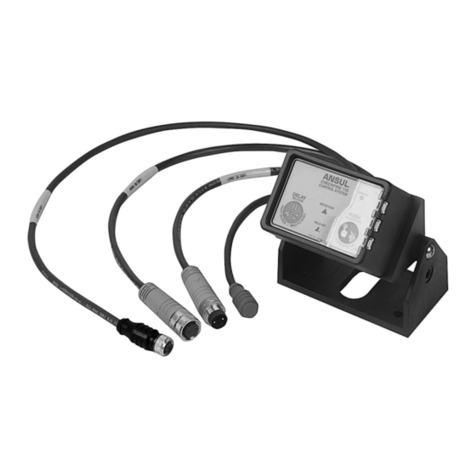
Ansul
Ansul CHECKFIRE 110 Planning, installation, operation, and maintenance manual
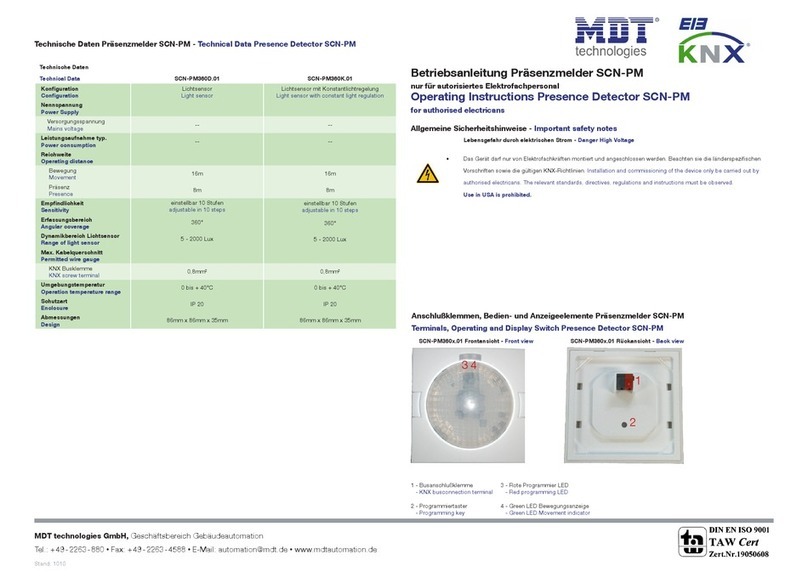
MDT Technologies
MDT Technologies SCN-PM series operating instructions

Petzl
Petzl VERSO D19 manual
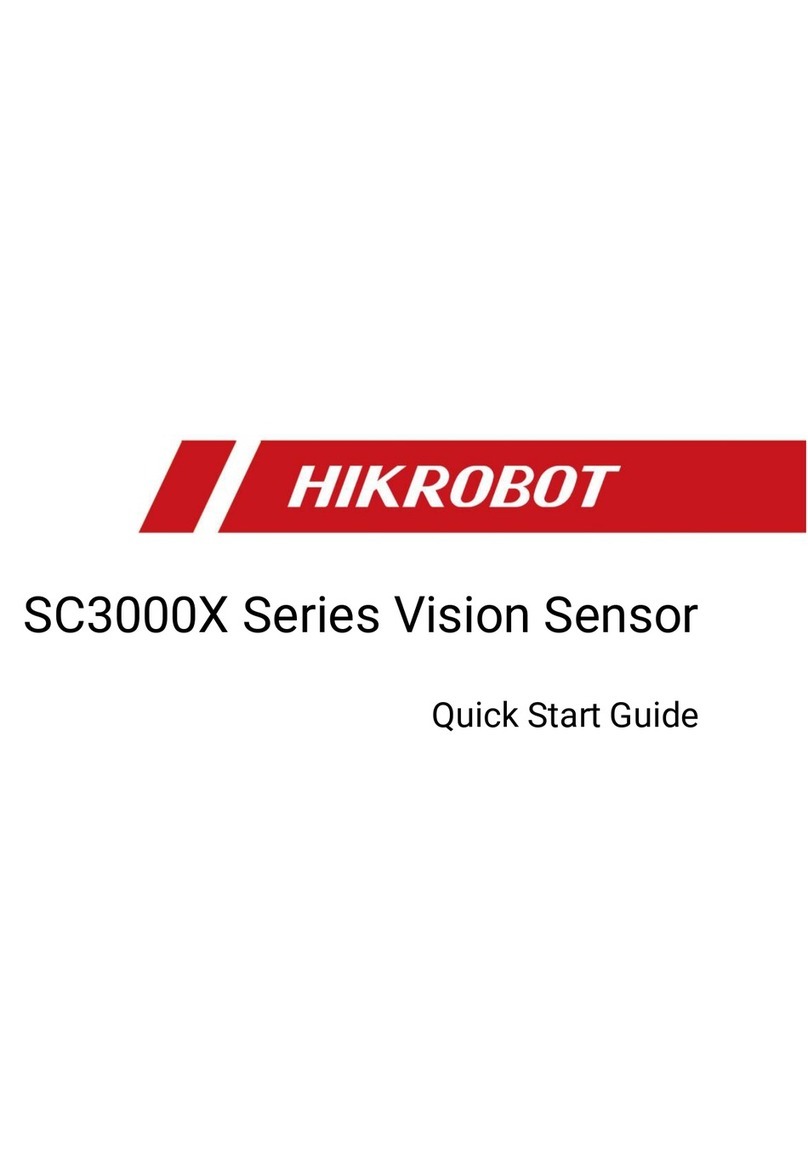
HikRobot
HikRobot SC3000X Series quick start guide
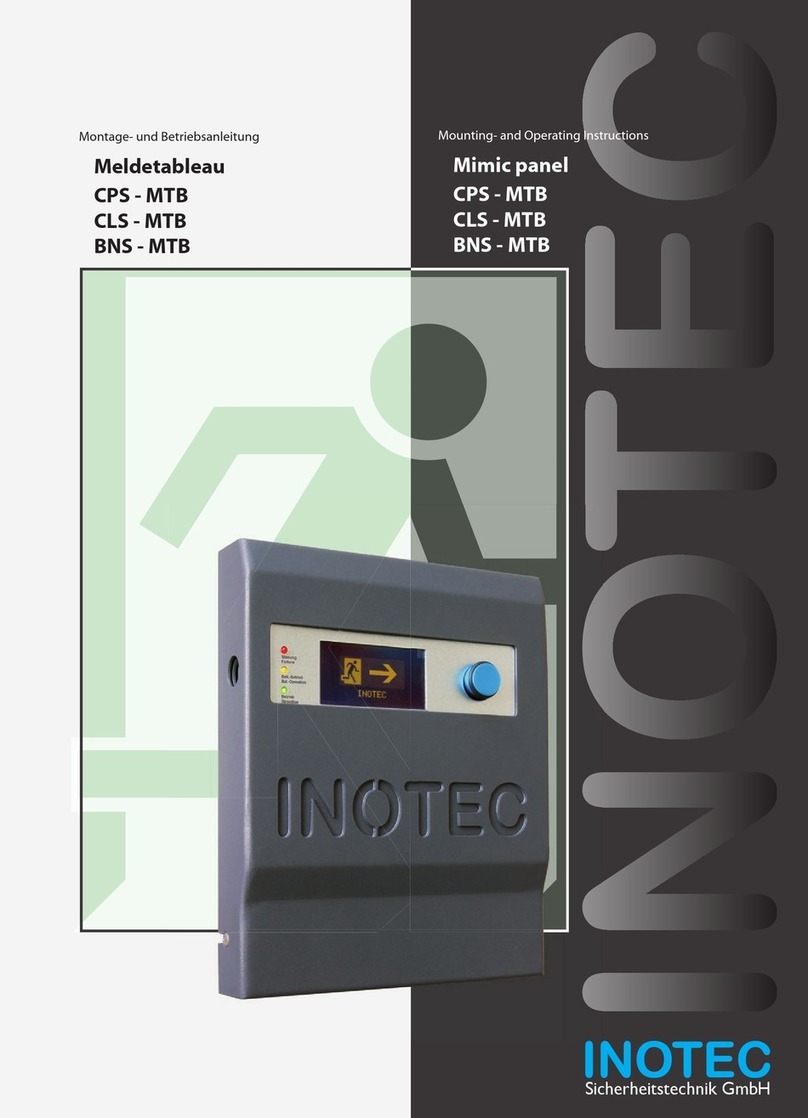
InoTec
InoTec CPS-MTB Mounting and operating instructions
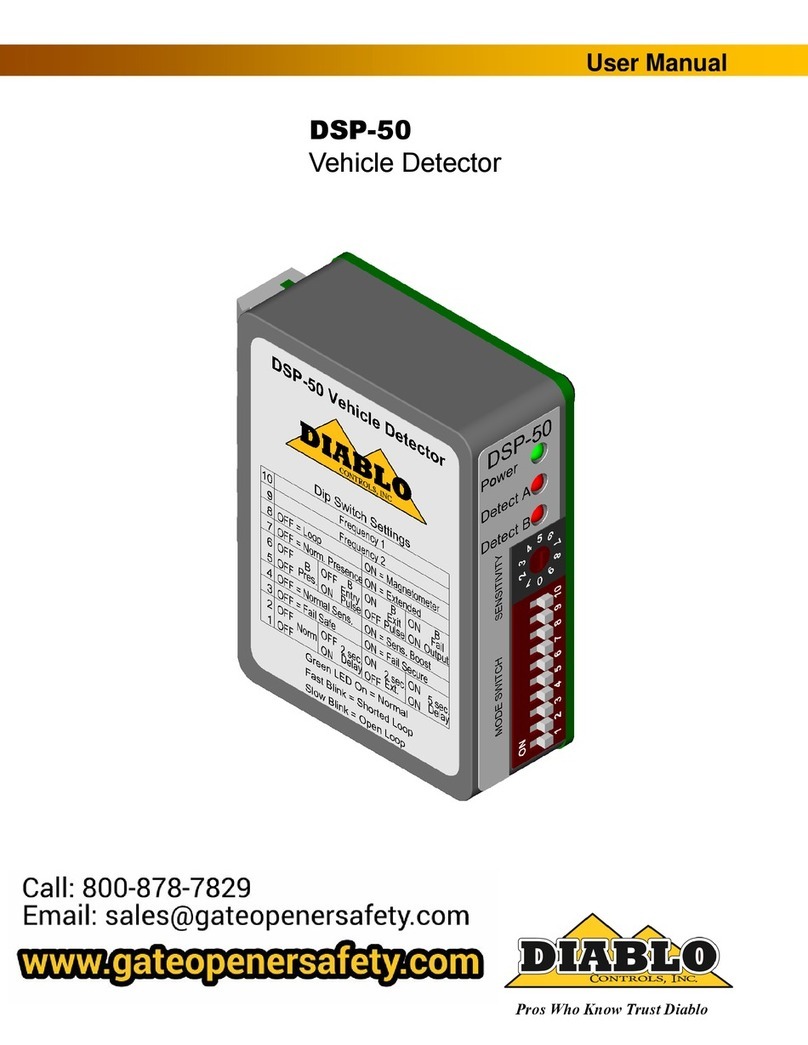
Diablo Controls
Diablo Controls DSP-50 user manual
